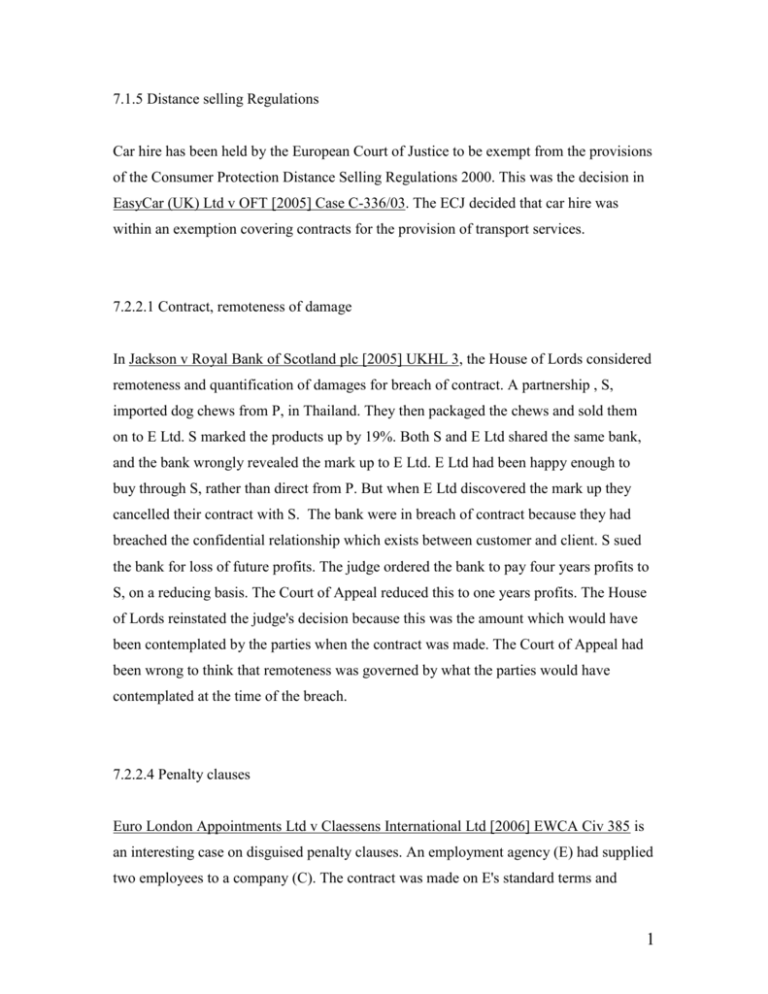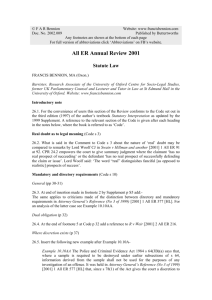As from October 1 2006, The Employment Equality (Age)
advertisement

7.1.5 Distance selling Regulations Car hire has been held by the European Court of Justice to be exempt from the provisions of the Consumer Protection Distance Selling Regulations 2000. This was the decision in EasyCar (UK) Ltd v OFT [2005] Case C-336/03. The ECJ decided that car hire was within an exemption covering contracts for the provision of transport services. 7.2.2.1 Contract, remoteness of damage In Jackson v Royal Bank of Scotland plc [2005] UKHL 3, the House of Lords considered remoteness and quantification of damages for breach of contract. A partnership , S, imported dog chews from P, in Thailand. They then packaged the chews and sold them on to E Ltd. S marked the products up by 19%. Both S and E Ltd shared the same bank, and the bank wrongly revealed the mark up to E Ltd. E Ltd had been happy enough to buy through S, rather than direct from P. But when E Ltd discovered the mark up they cancelled their contract with S. The bank were in breach of contract because they had breached the confidential relationship which exists between customer and client. S sued the bank for loss of future profits. The judge ordered the bank to pay four years profits to S, on a reducing basis. The Court of Appeal reduced this to one years profits. The House of Lords reinstated the judge's decision because this was the amount which would have been contemplated by the parties when the contract was made. The Court of Appeal had been wrong to think that remoteness was governed by what the parties would have contemplated at the time of the breach. 7.2.2.4 Penalty clauses Euro London Appointments Ltd v Claessens International Ltd [2006] EWCA Civ 385 is an interesting case on disguised penalty clauses. An employment agency (E) had supplied two employees to a company (C). The contract was made on E's standard terms and 1 conditions. Both employees left within 12 weeks. The terms of the contract between C and E, in clause 3.1, provided that if the employees left within 12 weeks a full refund of the contract price would be made. They also provided, in clause 4.1, that if the full contract price was not paid within 7 days of receipt of the invoice the right to a refund would be lost. The district judge found that the clause 4.1 was a disguised penalty clause and this view was upheld on appeal. However, the Court of Appeal overturned this decision and decided that clause 4.1 was merely a condition precedent, which had to be read along with clause 3.1. It was not a disguised penalty clause. If C did not pay within the time set out in clause 4.1, this was not a breach of contract. It did not make any difference that the time limit in clause 3.1 was the same as the one in clause 4.1. The two clauses were not interdependent. 12.2.1 Duty of care In Customs & Excise Commission v Barclays Bank plc [2006] UKHL 28 the House of Lords held that a bank, which had been informed by Customs that Customs had obtained a freezing order over the assets of two companies, did not owe a duty of care to Customs to comply with the freezing order. If the bank had breached the freezing order then a court could punish the bank for this. In a novel situation, such as this, the threefold test in Caparo v Dickman should be applied. The parties were not in a relationship of proximity. It would not be fair and reasonable to hold the bank liable. 12.2.4.1 Causation In John Anderson v Milton Keynes General NHS Trust [2006] the High Court refused to award damages for loss of a chance. A hospital trust had breached its duty of care by not telling a surgeon that a patient about to be operated upon had an infected wound, and by not treating the wound with antibiotics. The patient became disabled but received no 2 damages as, on a balance of probabilities, the outcome would have been the same even if the correct treatment had been administered. 12.2.4.2 Multiple causes in the tort of negligence In Barker v Corus (UK) plc [2006] the House of Lords held that an employee who was negligently exposed to asbestos dust by several employers could sue any of the employers, even if he could not prove which exposure had caused his mesothelioma. (However, it was emphasised that the mesothelioma cases are an exception to the general rule of causation.) The correct approach was to calculate the chance of the disease arising that each employer had caused. Each employer would therefore be liable only for his percentage chance of his having caused the disease, with no liability to contribute for the chance caused by other employers. This decision was a blow for many claimants. Many employers who exposed workers to asbestos have gone out of business. Existing employers will not have to contribute for the share of these now non-existent employers. 12.2.6.1 Contributory negligence In Ehrari v Curry [2006] EWHC 1319 the High Court held a child of nearly 14 who walked into a a road without first looking for traffic to be 70% responsible for the accident. She was hit by a truck driving at 20 mph. The truck driver was negligent in that he had not seen the child at all even though he knew that children were in the area. 12.4.3 Defective products under the Consumer Protection Act 1987 In Tesco Stores Ltd & Anor v Pollard [2006] EWCA Civ 393 the Court of Appeal considered the meaning of a defective product under the Consumer Protection Act 1987. 3 A 13 month old toddler had been injured on account of ingesting dishwasher powder. The Court of Appeal accepted the judge's finding that the toddler's mother had not negligently left the bottle open, but did not seem entirely to believe this. A product is defective under the Act if its safety is not such as persons generally are entitled to expect. The dishwasher powder had been in a bottle with a child resistant closure cap, which was more difficult to open than an ordinary screw top bottle However, the bottle top did not comply with the British Standard torque measure. The Court of Appeal held that the product was not defective. The public would expect the bottle top to be more difficult to open than an ordinary screw top, which it was. Members of the public were unlikely even to know about the existence of the British Standard, never mind what it required. 12.6 Limitation Act In Horton v Sadler Times 19 June 2006 the House of Lords held that the s.11 time limit on bringing a case for personal injury could be disapplied by the court where it appeared equitable to do this. 14.1.5.2 Section 75 of the Consumer Credit Act 1974 In OFT v Lloyds TSB Bank Ltd and Others [2006] EWCA Civ 268 the Court of Appeal held that liability under s.75(1) Consumer Credit Act 1974 arose even where the credit card transaction took place abroad. It made no difference that the credit card transaction took place within a four-party structure, rather than within the more common three-party structure. 15.2 Definition of a partnership 4 In Lees v Young Legal associates and Others [2006] EWCA Civ 613 the Court of Appeal held that a person could be a partner in a firm even though he was not entitled to share in its profits. L became a partner in a legal firm, Z, solely so that the firm could satisfy the Solicitors' Practice Rules 1990, which require a legal firm to have at least one partner qualified to supervise. When the firm was sued, L claimed not to be a partner and therefore not to be jointly liable for the firm's debts. L did not contribute any capital to the firm and did not have a right to participate in profits. Instead, he was to receive a fixed annual sum. The Court of Appeal held L to be a partner, applying the definition in s.1(1) Partnership Act 1890. There was a business which was carried on with a view to profit, and L carried it on in common with the other partners. L and the other partners intended to comply with the Solicitors' Practice Rules 1990, and so they must have intended to make a contract to be partners. 18.6.2 Illegal payment of dividends In It's a Wrap Ltd v Gula Times 9 June 2006 the Court of Appeal held that substantial dividends, paid otherwise than out of profits, had to be repaid to the company. The recipients knew, or had reasonable grounds to suspect that the dividends had been paid in contravention of the Companies Act 1985. 20.1 Agency workers as employees In Cable and Wireless PLC v Muscat [2006] EWCA Civ 220 the Court of Appeal approved the its own decision in Brook Street Bureau v Dacas [2004]. 21.2 Harassment in sex discrimination 5 The Employment Equality (Sex Discrimination) Regulations 2005 have amended the Sex Discrimination Act 1975 to include a new section 4A which defines harassment. 21.3.2 Discrimination 'on racial grounds' In Refearn Serco Ltd EAT/0153/05/LA the EAT held that an employee who was dismissed for standing as a BNP canditate in local elections was dismissed on racial grounds. This decision has been reversed by the Court of Appeal. The driver worked with several Asians and his job required him to drive Asian people around but there had never been any complaint made about him. The EAT also said that s.56(1) of the RRA provided that a remedy under the Act need be awarded only where this is just and equitable. 21.3 Introduction of the Commission for Equality and Human Rights (CEHR) The Equality Act 2006 has introduced a Commission for Equality and Human Rights (CEHR), which will be in operation as from October 2007. The CEHR will take over the work of the Commission for Racial Equality (but not until March 2009) and that of the Equal Opportunities Commission and the Disability Rights Commission. It will also dealwith inequality based on sexual orientation or religious grounds. The Act also requires public authorities to promote equality when carrying out public functions. 21.4.6 Discrimination against part-time employees The House of Lords held in Mathews and Others v Kent and Medway Towns Fire Authority [2006] UKHL 8, that part-time fire fighters were entitled to equal treatment as regards full-time fire-fighters. This was because the work which they did was broadly similar to that done by full-time fire-fighters. and differences in treatment could not be 6 justified on objective grounds. The correct approach under the Regulations is first to establish whether the two groups were employed on the same type of contract, and then to concentrate on similarities between the work done by both groups. It did not matter that the full-timers had additional duties. The approach is not the same as the one used under the Equal Pay Act 1970 because it is inevitable that part-time work is in some ways different from full-time work. 21.5 Age discrimination As from October 1 2006, The Employment Equality (Age) Regulations 2006 outlaw discrimination on the grounds of age. Direct discrimination, indirect discrimination, harassment and victimisation will be outlawed 22.4.1.2 New Safety Regulations The General Product Safety Regulations 1994 have been replaced by the General Product Safety Regulations 2005. The new Regs are very little different from the ones they replace. However, if an unsafe product placed on the market is known to be unsafe, both producers and distributors have a duty to notify enforcement authorities, explaining what action has been taken to reduce risk to consumers. 7







